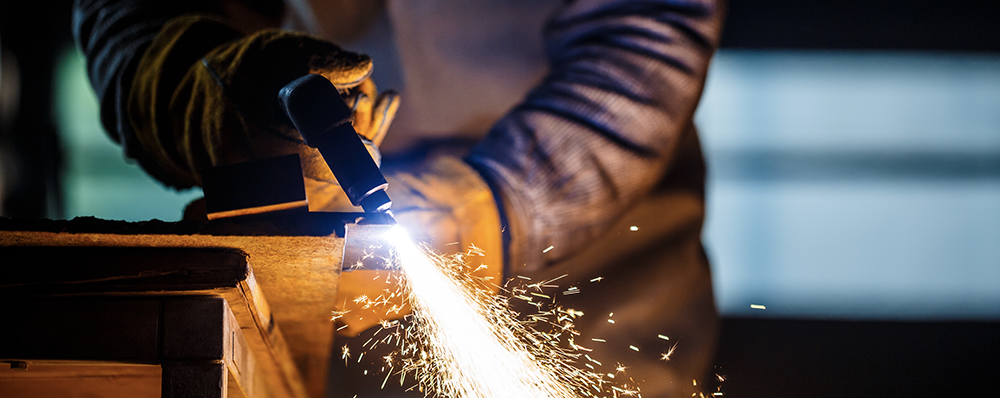For a beginner, even figuring out what equipment you need for welding can feel like a daunting task. Many first-timers get all set up, thinking they have everything, only to realize there are still a few items they lack before they can strike an arc. We’re here to remedy that issue by talking about welding equipment for beginners. This is a complete guide on exactly what types of welding equipment you’ll need to start stick, MIG, or TIG welding.
BESIDES THE WELDING MACHINE
Regardless of which process you decide to use, there’s some essential welding equipment every welder will need. The first and most important piece of equipment is protective gear for welding equipment safety. Yes, the welding arc is a fire hazard if you’re not careful. But even if you’re welding properly, the arc creates powerful UV rays. That means any exposed body parts are going to get fried. You’ll need a helmet, gloves, pants, and a heavy-duty long-sleeve shirt or jacket. Many welders also use a welding apron to protect their clothing.
You’ll also need good ventilation where you weld. The benefit of welding indoors is that you don’t have to deal with moisture or wind messing up your welds, but the toxic fumes might also have nowhere to go. A fume extractor is a big purchase for a beginner, but if you’re working somewhere without ventilation, it can be worth it.

While there’s a significant amount of accessories that depend on the type of welds you’re doing, clamps are important for almost any type of welding. Not only do they stabilize your project, but they can help prevent warping.
Finally, you’ll often need to clean the material you’re welding before you start. Paint, dirt, and other contaminants (if not removed) will ruin your beads. Generally, you’ll also clean up your welds or any mistakes after you finish. Both grinders and wire brushes are the most common equipment for this, although the specifics really depend on your material.
STICK WELDING EQUIPMENT
While not the easiest process to learn, stick welding typically has the cheapest starting costs. All you need is the machine and some welding rods. Basically, stick welding combines your filler, your protective gas, and the electrode into a single rod.
Which rods you need depends on the situation and the material you’re welding. Check out our more in-depth guide here.
Keep in mind that your rods will begin to degrade after being exposed to the atmosphere. Basically, they’ve got a limited shelf life that is decreased even more once you open the packaging. ESAB has introduced new VacPac electrodes that have a virtually limitless shelf life until opened. Many stick welders also invest in a rod oven to help extend the life of their electrodes once their packaging is opened.
In summary, for stick welding, you’ll need:
- Stick Machine
- Electrodes (rods)

MIG WELDING EQUIPMENT
MIG welding is generally considered the easiest process to learn, but it also requires more equipment than stick welding. First, you’ll need a MIG welding machine. Most MIG machines also come with a MIG gun and a work cable and clamp.
Unlike stick welding, MIG welding requires protective gas (the protective gas for the stick is fused right into the rods). When you buy a MIG welder, it doesn’t come with the gas or cylinders to store the gas. You can buy cylinders online for the best price, but you’ll need to find somewhere local to fill the cylinders.
Gas cylinders can be dangerous if they tip over, so make sure you have a way to secure them. You’ll also need a regulator/flow gauge and a hose to connect your cylinder to your machine. Some machines (like the Multimatic 211) come with a regulator and hose, while others do not. Make sure you check beforehand to know what equipment you need.
Finally, you’ve got your consumables. MIG uses wire for its filler. Some machines come with a starter roll of wire, others won’t. You’ll also want extra welding tips for your MIG gun, as the tips deteriorate over time and need to be replaced. As a final note, both the type of wire you use and the tips all depend on the MIG gun. Make sure they are all compatible before you purchase.
You might want to pick up an extra MIG gun liner as well. Over time, the liner will wear down, so it’s nice to have an extra on hand.
In summary, for MIG welding, you’ll need:
- MIG machine
- MIG gun
- Extra MIG gun liner
- Shielding gas equipment including gas, cylinder to store the gas, regulator/flowmeter, and gas hose.
- MIG welding wire
- Extra welding tips for MIG gun

TIG WELDING EQUIPMENT
TIG is considered the most difficult form of welding to learn, though the amount of equipment you’ll need is quite similar to MIG, with some key differences. First off, you’ll need a machine capable of TIG welding and a TIG torch. If you’re looking to purchase a multi-process machine, many of these don’t include a TIG torch or other accessories needed to TIG weld. If this is the case, make sure you purchase a TIG torch that’s compatible with your machine.
Some TIG machines also come with a foot pedal (foot amptrol). These allow you to adjust your amps as you weld, giving you incredibly precise control. However, most TIG machines don’t require them, and you can usually set your amps from the machine itself like you would with stick or MIG. That being said, only the more experienced TIG welders do not use the foot amptrol since you have less control over your weld, making it more difficult.
Unlike MIG and stick, TIG welding separates the electrode and filler material. A tungsten electrode is used inside the TIG torch and will need to be replaced from time to time. As one hand holds the torch, the other hand daps the metal filler rod. The type of metal filler rod you use depends on what material you’re welding. Some machines might include a filler rod and an electrode, but many won’t, so make sure you check before you get ready to weld.
Finally, you’ll need protective gas equipment to keep your weld pool from being contaminated. Similar to MIG, you’ll need to purchase a gas cylinder to store your protective gas. You’ll also need a regulator/flowmeter and a gas hose. Some machines include the regulator and hose (such as the Lincoln Square Wave TIG 200), but some don’t. Just make sure you check beforehand so you have everything you need.
In summary, for TIG welding, you’ll need:
- Welding Machine capable of TIG welding
- TIG Torch or electrode holder
- Shielding gas equipment including gas, cylinder to store the gas, regulator/flowmeter, and gas hose.
- Tungsten electrode
- Filler metal rod

Regardless of which process you use, it is important to know the best welding equipment for beginners. Getting started is often the most difficult part of welding because many beginners simply do not know how to choose the right welding equipment for their type of welding. However, we are here to help. For those looking to buy welding equipment, you’ll find the best prices from top brands at Welding Supplies from IOC.




